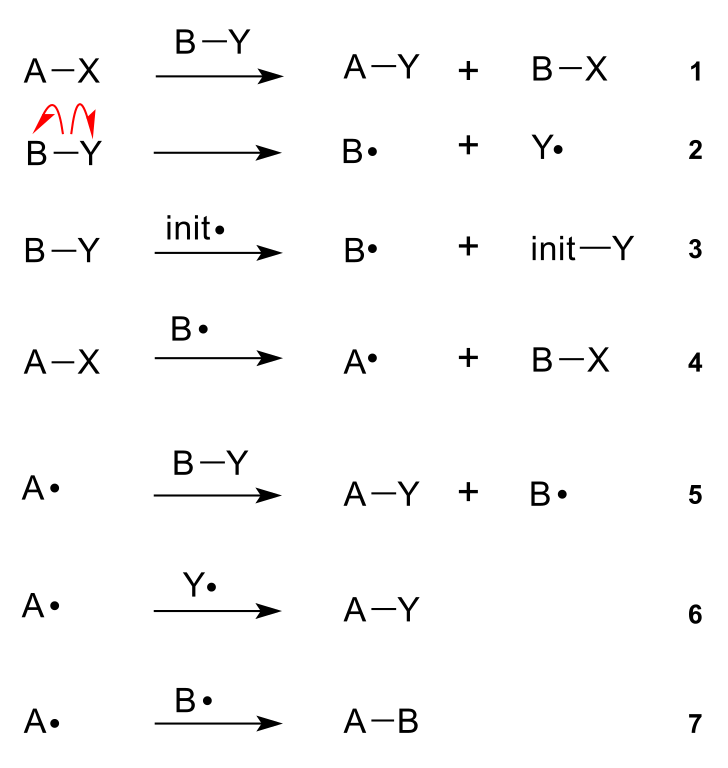What is the Difference Between Free Radical Substitution and Nucleophilic Substitution
Table of Contents
The key difference between free radical substitution and nucleophilic substitution is that free radical substitution reactions involve free radical chemical species having unpaired electrons, whereas nucleophilic substitution reactions involve nucleophiles having pairs of electrons that can be donated.
Free radical substitution is a type of organic synthetic chemical reaction in which one atom in a molecule is replaced by another atom or a group of atoms. Nucleophilic substitution, on the other hand, is a type of chemical reaction where an electron-rich chemical component tends to replace a functional group within an electron-deficient molecule.
CONTENTS
1. Overview and Key Difference
2. What is Free Radical Substitution
3. What is Nucleophilic Substitution
4. Free Radical Substitution vs Nucleophilic Substitution in Tabular Form
5. Summary – Free Radical Substitution vs Nucleophilic Substitution
What is Free Radical Substitution?
Free radical substitution is a type of organic synthetic chemical reaction in which one atom in a molecule is replaced by another atom or a group of atoms. Often, a free radical substitution reaction involves the breakdown of a carbon-hydrogen bond in alkanes like methane and propane. Thereafter, a new bond forms, which also happens in alkyl groups such as methyl and ethyl.

Figure 01: Free Radical Substitution in a General Molecule
For instance, ethanoic acid molecule contains a methyl group. It has a carbon-hydrogen bond that can behave similarly to those in methane molecules. Therefore, it can be ethane broken and replaced by something else in a similar way. E.g. reaction between methane and chlorine in the presence of UV light.
Free radicals can be described as atoms or groups of atoms having a single unpaired electron. Usually, a free radical substitution reaction involves this type of radicals. Free radicals form when a chemical bond splits evenly, where each atom gets one of the two bonding electrons. We call it hemolytic fission. When indicating if a chemical component is a free radical, we use a dot attached to the chemical formula to show the unpaired electron.
What is Nucleophilic Substitution?
Nucleophilic substitution is a type of chemical reaction where an electron-rich chemical component tends to replace a functional group within an electron-deficient molecule. The electron-rich chemical species is named as the nucleophile, and the electron-deficient species is called the electrophile. The chemical compound having the electrophile and the functional group is named as the substrate.

Figure 02: An Example of a Nucleophilic Substitution Reaction Mechanism
In this type of reaction, an electron pair of the nucleophile tends to attack the substrate molecule to bind with it. At the same time, the functional group departs the molecule. Therefore, we call it the leaving group. This leaving group departs with an electron pair. This reaction gives R-Nuc as the major product where R is the substrate molecule, and Nuc is the nucleophile. Sometimes, the nucleophile is electrically neutral or can be negatively charged. Similarly, the substrate is sometimes neutral or positively charged.
For example, hydrolysis of an alkyl bromide is a type of nucleophilic substitution. In that reaction, the nucleophile is a hydroxide group (OH-), and the leaving group is a bromide anion (Br-). Moreover, this type of reaction is very common in organic chemistry.
What is the Difference Between Free Radical Substitution and Nucleophilic Substitution?
Free radical substitution is a type of organic synthetic chemical reaction in which one atom in a molecule is replaced by another atom or a group of atoms. Nucleophilic substitution is a type of chemical reaction where an electron-rich chemical component tends to replace a functional group within an electron-deficient molecule. The key difference between free radical substitution and nucleophilic substitution is that free radical substitution reactions involve free radical chemical species having unpaired electrons, whereas nucleophilic substitution reactions involve nucleophiles having pairs of electrons that can be donated.
The below infographic presents the differences between free radical substitution and nucleophilic substitution in tabular form for side by side comparison.
Summary – Free Radical Substitution vs Nucleophilic Substitution
The key difference between free radical substitution and nucleophilic substitution is that free radical substitution reactions involve free radical chemical species having unpaired electrons, whereas nucleophilic substitution reactions involve nucleophiles having pairs of electrons that can be donated.
Reference:
1. “What Is Free Radical Substitution?” Chemistry LibreTexts, Libretexts, 13 Sept. 2020.
Image Courtesy:
1. “FreeRadicalSubstitutionGeneralDescr (1)” By V8rik at English Wikipedia (CC BY-SA 3.0) via Commons Wikimedia
2. “VicariousNucleophilicSubstitution” By English language Wikipedia user V8rik (CC BY-SA 3.0) via Commons Wikimedia
ncG1vNJzZmivp6x7pbXFn5yrnZ6YsqOx07CcnqZemLyue9ahmK1lmah6tbTEZpuinpaav6a6wp5km52krLKmuoyfqZ6dXaeupbXCmqNmq6WXwLW1066roqeeYq6vsIynrJyklaS9qbXLoppmq6WXwLW1066roqeeZA%3D%3D